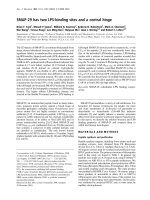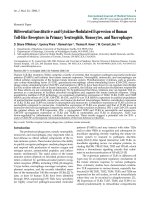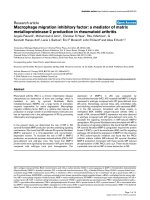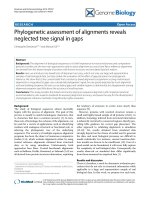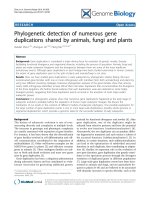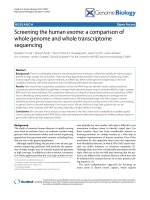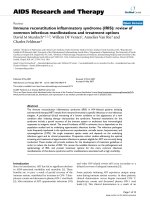Báo cáo y học: " Phylogenetic history demonstrates two different lineages of dengue type 1 virus in Colombia" pot
Bạn đang xem bản rút gọn của tài liệu. Xem và tải ngay bản đầy đủ của tài liệu tại đây (1.39 MB, 12 trang )
RESEARC H Open Access
Phylogenetic history demonstrates two different
lineages of dengue type 1 virus in Colombia
Jairo A Mendez
1,4*
, Jose A Usme-Ciro
2
, Cristina Domingo
3,5
, Gloria J Rey
1
, Juan A Sanchez
4
, Antonio Tenorio
3
,
Juan C Gallego-Gomez
2
Abstract
Background: Dengue Fever is one of the most important viral re-emergent diseases affecting about 50 million
people around the world especially in tropical and sub-tropical countries. In Colombia, the virus was first detected
in the earliest 70′s when the disease became a major public health concern. Since then, all four serotypes of the
virus have been reported. Although most of the huge outbreaks reported in this country have involved dengue
virus serotype 1 (DENV-1), there are not studies about its origin, genetic diversity and distribution.
Results: We used 224 bp corresponding to the carboxyl terminus of envelope (E) gen e from 74 Colombian isolates
in order to reconstruct phylogenetic relationships and to estimate time divergences. Analyzed DENV-1 Colombian
isolates belonged to the formerly defined genotype V. Only one virus isolate was clasified in the genotype I, likely
representing a sole introduction that did not spread. The oldest strains were closely related to those detected for
the first time in America in 1977 from the Caribbean and were detected for two years until their disappearance
about six years later. Around 1987, a split up generated 2 lineages that have been evolving separately, althou gh
not major aminoacid changes in the analyzed region were found.
Conclusion: DENV-1 has been circulating since 1978 in Colom bia. Yet, the phylogenetic relationships between
strains isolated along the covered period of time suggests that viral strains detected in some years, although
belonging to the same genotype V, have different recent origins corresponding to multiple re-introduction events
of viral strains that were circulating in neighbor countries. Viral strains used in the present study did not form a
monophyletic group, which is evidence of a polyphyletic origin. We report the rapid spread patterns and high
evolution rate of the different DENV-1 lineages.
Background
Dengue virus infection has been an important impact on
humans over the last several years, with an estimated 50
million dengue infections and an average of 1 million
cases reported annually in more than 100 countries in
tropical and subtropical regions [1-5]. This mosquito-
borne flavivirus causes a wide spectrum of clinical mani-
festations in humans, which include an acute self-limited
flu-like illness known as dengue fever (DF). DF is char-
acterized by headache, myalgia, arthralgia, retro-orbital
pain and sometimes maculopapular rash. Dengue hae-
morrhagic fever (DHF) is a se vere illness documented
by haemoconcentration (haematocrit increase by 20%)
and evidence o f plasma leakage such as pleural effusion
and a scites as the major pathophysiological features. In
some patients, DHF may progress to hypovolemic shock
(Dengue Shock Syndrome, DSS) with circulatory failure
[2,6-8].
Dengue virus (DENV) is an e nveloped virus with a
positive sense ssRNA of about 11 kb coding a single open
reading frame for three structural proteins, core (C), pre-
membrane/membrane (prM/M) and envelope (E), and
seven non-structural proteins (NS1, NS2a, NS2b, NS3,
NS4a, NS4b, NS5). Based on serological analysis, DENV
can be differentiated as four distinct serotypes (DENV-1,
DENV-2, DENV-3 and DENV-4), each one with the
capacity to infect and cause even the more severe mani-
festation, although some serotypes have been isolated
more frequently in DHF epidemics. On the other hand,
evolution studies and molecular epidemiology using
* Correspondence:
1
Laboratorio de Virología, Instituto Nacional de Salud, Avenida/Calle 26 No.
51-20, Bogotá D.C.,Colombia
Full list of author information is available at the end of the article
Mendez et al. Virology Journal 2010, 7:226
/>© 2010 Mendez et al; licensee BioMed Central Ltd. This is an Open Access article distributed under the terms of the Creative Commons
Attribu tion L icense ( censes/by/2.0), which permits unrestricted use, distribution, and reproduction in
any medium, provided the original work is properly cited.
nucleotide sequences from the DENV genome have
demonstrated the occurrence of genotype clades within
each serotype [9-28]. For this reason, genetic characteri-
zation of D ENV has become a critical issue for under-
standing epidemic patterns of viral spread. At the same
time, the important role of DENV itself in disease sever-
ity has also been proposed rather than the i mmune
enhancement develope d after subse quent infec tion with
heterologous serotypes [1,7,29]. The increase in virus
transmission over the last 50 years has possibly increased
its adaptive potential. In addition, host factors such as
the age, race, presence of non-neutralazing cross-reactive
antibodies and possibly chronic diseases could act as
selective pressures, resulting in more virulent genotypes
that may be associated with DHF/DSS [9,17,29-34].
Four DENV serotypes have been involved in Colom-
bian epidemics, although DENV-1 and DENV-2 have
the higher circulation rate since 1971[5,6, 21]. Moreover,
sincethefirstcaseofDHFinColombiaattheendof
1989, these two serotypes have been associated with
severe disease. To date, DENV-1 falls into five clades
designated as genotype I (Southeast Asia, China and
East Africa), genotype II (Thailand), genotype III
(Malaysia), genotype IV (South Pacific) and genotype V
(America, Africa). Additio nally, the existence of lineages
with dist inctive geographical and temporal relationships
had been suggested [12,20,26,28,35-38]. Due to the
importance of DENV in public health, the particular
goals of this research were to reconstruct the phyloge-
netic history of DENV-1 and to date the phylogenetic
tree using isolation time as calibration points to estab-
lish date of introduction of virus and rate evolution
patterns of virus in Colombia.
Results
Virus recovery and confirmation
Seventy four viruses obtained from symptomatic
patients were isolated in mosquito cell culture and sub-
sequently identified as DENV-1 serotype by monoclonal
antibodies and confirmed by RT-PCR methods. From
the 74 samples, it was not possible to obtain the exact
geographic origin of 10 samples. The remaining 64 iso-
lates are listed in Table 1 indicating locality, isolation
year, accession number and genotype.
Phylogenetic reconstruction of DENV-1
Sequences from the carboxyl terminus of the envelope
(E) gene from the 74 Colombian DENV-1 isolates were
aligned in CLUSTAL W [39,40] and compared with 52
previously reported sequences elsewhere, resulting in a
trivial alignment as long as there were no indels in the
sequences alignment. The Maximum Likelihood analysis
comparing 126 sequences is presented in figure 1.
Previously reported genotypes were represented in the
tree and placed most of the Colombian isolates nesting
in the genotype V clade (America, Africa) and were
closely related to Argentina, Brazil and Paraguay virus
strains. Nevertheless, the oldest sequences
DENV-1/CO/261_Atlantico/1978, DENV-1/CO/
263_Choco/1979 and DENV-1/CO/150_Choco/1979
were slightly distant from the remaining strains and
appeared in close proximity to some Caribbean Island
and other American isolates (Trinidad, French Guinea).
Interestingly, the isolate DENV-1/CO/267_Valle/1983
appeared in a different clade, as the sister branch of
Japan (DENV-1/JP/Mochizuki/1943), China (DENV-1/
CN/GZ-80/1980), Ethiopia (DENV-1/DJ/Ethiopia/1998)
and Cambodia (DENV-1/KH/1998) strains, which have
been defined as lineages of the genotype I [26]. To allow
a bett er resolution of the tree, we performed a phyloge-
netic reconstruction using only the Colombian isolates.
Again, the oldest isolates were more divergent repre-
senting the first entrance of virus in Colombia. Although
the genotype V was the only represented in the tree, two
different lineages may be defined based on cladal distri-
bution (figure 2).
Molecular clock
We used a Bayesian inference based on MCMC to
reconstruct Colombian DENV 1 coalescent history.
BEAST allowed t he use o f isolation year as calibrating
point to estimate divergence time and then generated
a posterior probability (PP) distribution of trees
instead of a bootstrap value [41-44]. The resulting tree
clearly placed the genotypes of DENV-1 already circu-
lating globally before the first appearance of this sero-
type in the Americas between 1970 and 1980
(figure 3). According to the 95% highest posterior den-
sity (HPD) beneath the strict clock model, the esti-
mated root for this phylogeny was 1929 and the
substitution rate was 8.58 × 10
-4
substitutions per site,
per year. To increase resolution, we use the strict
molecular clock model to reconstruct Colombian iso-
lates (figure 4). Under the assumption of a constant
substitution rate, the estimated root indic ates 1945 as
the date of the more recent common ancestor. In
addition, there was a split up around 1987 between
DENV-1/CO/188_Guaviare/1987 isolates and the
remaining strains (PP = 0,82). As the time goes by, we
can see a sustained increase in number of isolates and
a rapid spread of viruses, which included few changes
among them as seen with the branch lengths. By the
year 1992 (approximately), another remarkable parti-
tion event occurred to generate 2 well defined clades
(PP = 0,77 and 1), evolving independently since the
early 9 0′s until recent time.
Mendez et al. Virology Journal 2010, 7:226
/>Page 2 of 12
Table 1 Colombian DENV-1 isolates sequenced and analyzed in the present study
ISOLATE* LOCALITY ISOLATION YEAR GENOTYPE/LINEAGE** ACCESSION NUMBER
DENV-1/CO/261_Atlantico/1978 Atlántico 1978 V/1 HM067643
DENV-1/CO/150_Choco/1979 Chocó 1979 V/1 HM067617
DENV-1/CO/263_Choco/1979 Chocó 1979 V/1 HM067644
DENV-1/CO/267_Valle/1983 Valle 1983 I HM067645
DENV-1/CO/188_Guaviare/1987 Guaviare 1987 V/1 HM067618
DENV-1/CO/191_SanAndres/1996 San Andrés 1996 V/2 HM067619
DENV-1/CO/192_Santander/1997 Santander 1997 V/1 HM067620
DENV-1/CO/255_Santander/1997 Santander 1997 V/1 HM067642
DENV-1/CO/589_Casanare/1997 Casanare 1997 V/1 HM067678
DENV-1/CO/98_SanAndres/1998 San Andrés 1998 V/1 HM067615
DENV-1/CO/196_Huila/1998 Huila 1998 V/1 HM067621
DENV-1/CO/197_Santander/1998 Santander 1998 V/1 HM067622
DENV-1/CO/198_Tolima/1998 Tolima 1998 V/1 HM067623
DENV-1/CO/199_Cundinamarca/1998 Cundinamarca 1998 V/1 HM067624
DENV-1/CO/204_Arauca/1998 Arauca 1998 V/2 HM067625
DENV-1/CO/206_SanAndres/1998 San Andrés 1998 V/1 HM067626
DENV-1/CO/207_SanAndres/1998 San Andrés 1998 V/1 HM067627
DENV-1/CO/208_SanAndres/1998 San Andrés 1998 V/1 HM067628
DENV-1/CO/210_SanAndres/1998 San Andrés 1998 V/1 HM067629
DENV-1/CO/211_SanAndres/1998 San Andrés 1998 V/1 HM067630
DENV-1/CO/251_Arauca/1998 Arauca 1998 V/2 HM067638
DENV-1/CO/252_SanAndres/1998 San Andrés 1998 V/1 HM067639
DENV-1/CO/269_Santander/1998 Santander 1998 V/1 HM067646
DENV-1/CO/270_Santander/1997 Santander 1998 V/1 HM067647
DENV-1/CO/280_Cundinamarca/1998 Cundinamarca 1998 V/2 HM067649
DENV-1/CO/319_Arauca/1998 Arauca 1998 V/1 HM067651
DENV-1/CO/498_Casanare/1998 Casanare 1998 V/2 HM067666
DENV-1/CO/501_Bogota/1998 Bogotá 1998 V/2 HM067669
DENV-1/CO/597_Huila/1998 Huila 1998 V/1 HM06768
DENV-1/CO/324_Cundinamarca/1998 Cundinamarca 1998 V/2 HM067652
DENV-1/CO/515_Guaviare/1999 Guaviare 1999 V/2 HM067676
DENV-1/CO/521_Amazonas/1999 Amazonas 1999 V/2 HM067677
DENV-1/CO/213_Caqueta/2000 Caquetá 2000 V/2 HM067631
DENV-1/CO/214_Nariño/2000 Nariño 2000 V/2 HM067632
DENV-1/CO/215_Cesar/2000 Cesar 2000 V/2 HM067633
DENV-1/CO/216_Cachicamo/2000 Guaviare 2000 V/2 HM067634
DENV-1/CO/253_Nariño/2000 Nariño 2000 V/1 HM067640
DENV-1/CO/277_Nariño/2000 Nariño 2000 V/1 HM067648
DENV-1/CO/288_Cachicamo/2000 Guaviare 2000 V/2 HM067650
DENV-1/CO/329_Caqueta/2000 Caquetá 2000 V/2 HM067653
DENV-1/CO/485_Caqueta/2000 Caquetá 2000 V/2 HM067663
DENV-1/CO/499_Guaviare/2000 Guaviare 2000 V/2 HM067667
DENV-1/CO/506_Cesar/2000 Cesar 2000 V/2 HM067671
DENV-1/CO/508_Tolima/2001 Tolima 2001 V/2 HM067672
DENV-1/CO/254_Quindio/2002 Quindío 2002 V/1 HM067641
DENV-1/CO/347_Quindio/2002 Quindío 2002 V/2 HM067654
DENV-1/CO/348_Quindio/2002 Quindío 2002 V/2 HM067655
DENV-1/CO/351_Guajira/2002 Guajira 2002 V/2 HM067656
DENV-1/CO/486_Quindio/2002 Quindío 2002 V/2 HM067664
DENV-1/CO/487_Quindio/2002 Quindío 2002 V/2 HM067665
DENV-1/CO/502_Guaviare/2002 Guaviare 2002 V/2 HM067670
Mendez et al. Virology Journal 2010, 7:226
/>Page 3 of 12
Discussion
Emerging and re-emerging diseases have become a pub-
lic health major concern in developing countries, where
dengue is perhaps the most important vector-borne viral
disease in terms of morbidity. In Co lombia, DF and
DHF had been associated to the four DENV serotypes
with DENV-2 and DENV-1 predominating since 1971
after the re-appearance and spread of Aedes (Stegomyia)
aegipty [6]. DENV-3 circulated for a short time in 1975
and then it was not detected until 2002 w hen re-intro-
ductio n occurred probably from Venezuela [27]. DENV-
4 has been detected sporadically every year since 1984,
when it was involved in several DF cases.
ThehugegeneticdiversityofDENVhasbeenvastly
documented, starting perhaps with the Rico-Hesse pro-
posal of d ifferent “genotypes” comprising serotypes 1
and 2 [10], f ollowing by several s tudies and genotype
definition of DENV-3 and DENV-4. In this way, five dif-
ferent genotypes has been previously defined for DENV-
1 (genotypes I to V) suggesting a significant genetic var-
iation. In fact, various lineages had been proposed based
on time-spatial clustering and clade distribution
[26,28,35-38]. In the present study, 74 Colombian
DENV-1 sequences were analyzed to try to reconstruct
the phylogenetic history of the virus in this country. Dif-
ferent genome regions have been used to infer DENV
phylogeny including those with short fragments
[10,27,28]. Here we e mployed a sequence from the car-
boxi terminal of the envelope (E) protein which has
demonstrated to provide a useful phylogenetic signal to
define g enotype clustering [26]. It is important to n ote
that the better resolution of evolutionary patterns
should be obtained from complete genomes. However, it
was not possible to obtain largest fragments from the
oldest isolates, p robably because of RNA degradation
across the time. As expected, all strains were clustered
with those from Brazil, Paraguay, Argentina, and differ-
ent Caribbean Islands, corresponding to the formerly
named genotype V (America/ Africa), showing a w ell
supported clade clearly separated from the others geno-
types. Colombian strains DENV-1/CO/261_Atlantico/
1978, DENV-1/CO/263_Choco/1979 and DENV-1/CO/
150_Choco/1979, were separated from the remaining
isolates and appeared closer to those from the Carib-
bean islands, which represent the entrance of serotype 1
into the Americas. It was reported for t he first time in
1977 in Jamaica and rapidly spreading to the Antilles
including Cuba, Antigua & Barbuda, Aruba, Bahamas,
Barbados, Curaçao, Dominica, Grenada, Guadaloupe,
Guyana, Haiti, Martinique, Montserrat, Puerto Rico, St.
Kitts, St. Martin, St. Vincent and the Grenadines, Trini-
dad, Turks and Caicos, a nd the Virgin Islands [5]. In
1978, DENV-1 was implica ted in large mainland out-
breaks perhaps occurring at the same time in Colombia,
Venezuela, Surinam, F rench Guyana, and eventually
Centro America and Mexico. In Colombia, DENV-1 was
isolated between 1977 and 1978, so the strain DENV-1/
CO/261_Atlantico/1978 represen ts perhaps the first
virus entrance to the country. It rapidly spread until the
next isola tion in Choco (DENV-1/CO/263_Choco/1979
and DENV-1/CO/150_Choco/1979) and then it fades
away (or at less it was not reported) probably displaced
by DENV-2 (maintaining DENV-1 in a silent low circu-
lation) until 1985 when it established in different local-
ities. It is important to note that even with the mobi lity
between countries and increasing opportunity of viral
introduction, only one DENV-1 genotype is circulating
in America , different to D ENV-2 and DENV-3 of which
at least 2 genotypes has been detected (America/Asia
genotypes and I/III genotypes respec tively) suggesting
Table 1 Colombian DENV-1 isolates sequenced and analyzed in the present study (Continued)
DENV-1/CO/232_Meta/2003 Meta 2003 V/2 HM067635
DENV-1/CO/364_Caqueta/2003 Caquetá 2003 V/2 HM067657
DENV-1/CO/381_Valle/2003 Valle 2003 V/2 HM067658
DENV-1/CO/387_Valle/2003 Valle 2003 V/2 HM067659
DENV-1/CO/123_Putumayo/2004 Putumayo 2004 V/2 HM067616
DENV-1/CO/235_Putumayo/2004 Putumayo 2004 V/2 HM067636
DENV-1/CO/509_Huila/2004 Huila 2004 V/2 HM067673
DENV-1/CO/510_Huila/2004 Huila 2004 V/2 HM067674
DENV-1/CO/511_Huila/2004 Huila 2004 V/2 HM067675
DENV-1/CO/250_Putumayo/2005 Putumayo 2005 V/2 HM067637
DENV-1/CO/446_Putumayo/2005 Putumayo 2005 V/2 HM067660
DENV-1/CO/457_Putumayo/2005 Putumayo 2005 V/2 HM067661
DENV-1/CO/471_Guainia/2005 Guainía 2005 V/2 HM067662
* Internal isolations code, Laboratorio de Virología, Instituto Nacional de Salud
** Putative lineage established in the present study
Mendez et al. Virology Journal 2010, 7:226
/>Page 4 of 12
Figure 1 Evolutionary relationships of DENV-1. Phylogenetic tree of 126 DENV-1 isolates worldwid e. It was computed using the Maximum
Likelihood method. The optimal tree with the sum of branch length = 0.596 is shown. The tree is drawn to scale, with branch lengths in the
same units as those of the evolutionary distances used to infer the phylogenetic tree. Significant bootstrap values (≥ 50) are indicated. Clade
supporting the putative lineage 2 is show in red. Colombian isolates are in blue. There were a total of 221 positions in the final dataset.
Phylogenetic analyses were conducted in PAUP*
Mendez et al. Virology Journal 2010, 7:226
/>Page 5 of 12
Figure 2 Evolutionary relationships of DEN-1 Colombian isolates. The evolutionary history was inferred using the Maximum Likelihood
method. The optimal tree with the sum of branch length = 0.20353432 is shown. The confidence probability of each node was estimated using
the bootstrap test (1000 replicates) and values over 50% are presented. The tree is drawn to scale, with branch lengths in the same units as
those of the evolutionary distances used to infer the phylogenetic tree. The evolutionary distances were computed using the Maximum
Likelihood method and are in the units of the number of base substitutions per site. Square brackets indicate putative lineages 1 and 2.
Phylogenetic analyses were conducted in PAUP*
Mendez et al. Virology Journal 2010, 7:226
/>Page 6 of 12
perhaps, dissimilar patterns of viral spread and transmis-
sion between DENV genotypes and even different adap-
tation capacity.
Many researchers have categorized DENV in non offi-
cial taxonomic levels beneath genotype, based specially
in cladal distribution or geographical cluster ing. Circula-
tion of these “lineages” has been particularl y defined for
DENV-1 in India, where at least 4 different lineages had
been proposed (India-1 close to American strains, India-
2 related to Singapore 1993 isolate, India-3 in south
India and India-4 fr om Delhi and Gwalior) [26,28]. In
our study, a remarkable cladogenesis event occurs
around 1992 according to the molecular clock, generat-
ing two well supported clades corresponding to putative
Colombian DENV-1 lineages. Despite the eco-epide-
miology similarities between Colombia and neighbor
countries were dengue is a ma jor concern, lineages have
not b een previously demonstra ted for DENV-1. In fact,
according to ML phylogeny, most of the American
strains (Argentina and Brazil) correspond to the lineage-
1, leaving the lineage 2 restricted to Colombia. Although
geographic distribution of these lineages is not clearly
delimitated, it is evident that they are evolving indepen-
dently and most likely in parallel at the same localities.
Despite the emergence and rapid diversification of
DENV has been a matter of special concern, precise
mechanisms of evolution remain unclear [45-50]. It is a
fact that human RNA viruses inc luding Influenza, HIV,
Coronavirus, etc., have particularly increased mutation
and evolution rates mostly because of the lack of proof-
reading activity of RNA-dependent RNA-polymerase
[51,52]. Nevertheless, arthropod-borne viruses (Arbo-
viruses) have demonstrated slower mutation rates com-
paring with those infecting directly human host,
probably because of the trade-off effect occurring when
the virus is obligated to adapt alternatively into the
Figure 3 Molecular Clock of DENV-1.DENV-1divergencetimewasestimatedusingyearofisolation (scale used in the tree) as calibration
points under the strict molecular clock model using GTR+Γ+I parameters. Posterior Probability (PP) values are indicated for each node, and the
extent of the 95% highest posterior density (HPD) intervals for each divergence time is represented by the blue bars. Branches representing
America genotype including Colombian isolates were collapsed (presented in red) for clearness purposes. Root of the tree was previously
calculated by TRACE statistic interface of BEAST, and is placed in 1924 as the most recent ancestor
Mendez et al. Virology Journal 2010, 7:226
/>Page 7 of 12
Figure 4 Molecular Clo ck of DENV-1 Colo mbian Isola tes. Divergence time of DENV-1 C olombian isolates was estimated using year of
isolation (scale used in the tree) as calibration points under the strict molecular clock model using GTR+Γ+I parameters. Posterior Probability
(PP) values are indicated for each node, and the extent of the 95% highest posterior density (HPD) intervals for each divergence time is
represented by the blue bars. Root of the tree was previously calculated by TRACE statistic interface of BEAST, and is placed in 1945 as the most
recent ancestor. Taxa from the putative lineages 1 and 2 are shown in blue and red, respectively.
Mendez et al. Virology Journal 2010, 7:226
/>Page 8 of 12
invertebrate vector and vertebrate host [51]. This result-
ing constrain has been experimentally assessed in vivo
to Venezuelan Equine Encephalitis [52] and in vitro to
DENV [51] demonstrating that fitness improves when
virus specialize in a single cel l line but decreases in
virus undergoing alternative passages i n different cells.
In view of that, over all DENV mutation rates have been
previously inferred, ranging from 4.55 × 10
-4
(DENV-1)
to 9.01 × 10
-4
(DENV-3) [19]. In t he present study, we
found a mutation rate of 8.58 × 10
-4
substitutions per
site, per year, suggesting faster evolution rates for
Colombian strains, perhaps because of the high transmi-
tion occurrence especially in hyperend emic areas, where
virus replicates in several human hosts, reducing the
constraining effect occurred in the vector. However, this
high mutation rate does not necessarily reflect a fitness
advantage or a successful adaptation process. Actually,
positive selection for DENV seems to be serotype/geno-
type dependent and even more, protein specific. In fact,
envelope (E) protein apparently exhibits some adapta-
tion evidence in DENV-3, DENV-4 and various DENV-2
genotypes, but not for DENV-1, strongly suggesting a
purifying selection pressure, at least over this gene.
Nevertheless, further studies hav e to be done to try to
understand the adaptation process in DENV.
On the other hand, although mostly of Colombian
strains belong to the genotype V, there is an isolate,
DENV-1/CO/267_Valle/1983 placed into genotype I
near to Asia, China and East Africa strains. The ML
tree show this strain close to DENV-1/JP/Mochizuki/
1943, a strain c onsidered extinct. Since we do not have
this virus as reference in our labo ratory, we can discard
cross contamination during the assay. Moreover, the
presence of this virus could be explained based on the
migration process occurred from Asia to America, offi-
cially starting to Colombia by 1929, and sustained until
the mid XX century [53]. Thus, establishment of Asian
colonies increased visitors and perhaps favored the
entrance of viral strains. We can speculate that those
viruses did no t fit to the new environment and the
adaptation events were constrained because of the selec-
tive pressures including different vectors and human
immune response.
According to natural history of DENV, evolution
events could bring new genetic variants and eventually
increase the severity of disease. Although pathogenic
markers remain unclear, hemorrhagic features on some
Asian DENV-2 genotypes have been demonstrated and
Asian derived DENV-3 genotypes associated to dengue
fever and dengue hemorrhagic fever have been reported
in Brazil [25]. Moreover, changes in clinical manifesta-
tion of disease (atypical dengue) such as viscerotropism
or encephalitis may respond to the circulation of new
DENV lineages with increased pathogenic potential.
Consequently, epidemiological pro grams should incl ude
not just virological diagnosis but genotype surveillance
too.
Conclusion
This study shows in a defined time-scale, not just the
first entrance of DENV 1 in Colombia, but also the viral
evolution process in a highly endemic area. As a major
conc lusion, only one genotype of DENV 1 has been cir-
culating since the first epidemic reports in the continen-
tal area. Nevertheless, two different lineages have been
evolving fast since th e earliest 90′s according to molecu-
lar clock. As these evolution events may derive in a
marked pathogenic potential, surveillance programs
should include molecular methodologies. In fact, unu-
sual presentation of disease currently reported by local
health care institutions may be c orrelat ed to this evolu-
tion process. Further analyses by using at least complete
E gene should be done to corroborate our results.
Methods
Virus strains
DENV-1strainsusedinthisstudywereobtainedfrom
the virus collection of the National Health Institute
(INS, Virology Lab, Bogotá, Colombia), and compri se 74
isolates from outbreaks, epidemics and routine epide-
miological surveillance. Clini cal samples were collected
between 1978 and 2007 from different localities all
around the countr y, so they represent most viruse s cir-
culating in Colombia during the last 30 yea rs (Table 1).
All viral stocks were inoculated on C6/36 Aedes albopic-
tus cells gr owing in Eagle’s minimal essential medium
(E-MEM) supplemented with 2% fetal calf serum (FSC).
After 10 days of incubation at 28° C, mono layer was dis-
rupted and supernatant was then recovered by centrifu-
gation an d stored at -80°C until use. The remained cells
were washed with Phosfate Buffer Saline (PBS) and
dripped on slides; after fixed in cold acetone, slides were
incubated w ith monoclonal antibodies (anti-DENV-1 to
anti-DENV-4, kindly donated by CDC, Puerto Rico) for
one hour, washed with PBS and incubated again with a
fluorescent conjugated antibody. Additionally, DENV-1
serotype confirmation was done by reverse transcription
polymerase chain r eaction (RT-PCR) using specific pri-
mers [54].
Viral RNA extraction, RT-PCR and sequencing
Cell c ulture supernatants were used to extract viral RNA
using QIAamp Viral R NA Minikit (Qiagen, Germany)
following manufacturer ’s instructions. Briefly, 140 μlof
each supernatant was placed into 560 μl of AVL buffer
with 5.6 μl of carrier RNA and mixed with ethanol (96-
100%) before passed throug h a colum n by centrifugation.
After washing with buffers AW1 and AW2 RNA was
Mendez et al. Virology Journal 2010, 7:226
/>Page 9 of 12
finally eluted with 60 μl of AVE buffer and stored at -80°
C until use. Five microliters from each RNA extraction
were used as template in a one step RT-PCR reaction
(Qiagen, One-Step RT-PCR kit) as previously described
[55]. Primers used [DEN1S1871 (5′ -TGGCTGAGACC-
CARCATGGNAC-3′ ) and DEN1AS2622 (5′ -CAATT-
CATTTGATATTTGYTTCCAC-3′)] were designated to
amplify 751 bp from de joining region E/NS1. Reactions
were evaluated in 1% agarose gel stained with ethidum
bromide a nd reactions observed as negative were then
subjected to nest ed PCR as foll ow: 1 μl of initial RT-PCR
product, 1 × buffer B (60 mM Tris-HCl pH 8.5, 2 mM
MgCl
2
,15mM(NH
4
)
2
SO
4
), 40 pmol of each primer
[DEN1S2133 (5′ -GGAAAATGTTYGAAGCAACYG
CCC-3′ ), DEN1AS2553 (5′ -TCCTCCCATGCCTTCC-
CRATGG-3′)] and 2.5 U of Taq DNA Polimerase (Invo-
trogene) in a f inal volume o f 50 μl. PCR reactions were
first denaturated at 94°C (2 minutes) and then subjected
to 40 cycles of denaturation (94°C, 30 seconds), primer
annealing (57°C, 4 minutes), primer extension (72°C, 30
seconds) and a final extension step at 72°C for 5 minutes.
Nested PCR was evaluated in 1% agarose gel stained with
ethidium bromide.
Amplified products (from RT-PCR or nested PCR)
were purified using QIAq uick PCR Purification Kit
(QIAGEN, Germany) and then used as template for
sequencing reactions using the ABI Prism Dye Termi-
nator Cycle Sequencing Ready Reaction Kit (Applied
Biosystems, Foster City, CA). Sequencing w as carried
out on both strands with 10 pmol of primers used for
nested PCR, and t he products were analyzed using an
ABI model 377 automated sequencer (Applied Biosys-
tems, USA). Overlapping sequences for each sample
obtained from sense and antisense primers were com-
bined to obtain a consensus sequence using the Seq-
Man module of Lasergene (DNASTAR Inc. Software,
Madison, Wis.). A total of 224 bp [corresponding to
carboxyl terminus of envelope (E) gene] from 74 new
sequences were compared with 52 previously
sequenced strains from all over the world, available in
GenBank. Consensus sequences were aligned using the
program CLUSTAL W included in MEGA package
version 4.0 [35,36].
Phylogenetic analyses
Phylogenetic trees were constructed with the Maximum
Parsimony and Maximum Likelihood (ML) metho ds
incorporated in the PAUP* 4.0 program [56]. Phyloge-
netic analyses were performed by using the best model
of nucleotide substituti on based on Modeltest [57] (ana-
lyses are available upon request). Statistical significance
of tree topology was assessed with a bootstrap with
1000 replicates. Obtained trees were visualized using the
Tree View Program [58].
Substitution rates and molecular clock
In addition, estimated rate of evolutionary change (nucleo-
tide substitutions per site per year) and tree root age was
obtained with the program BEAST (Bayesian Evolutionary
Analysis by Sampling Trees)[41], which uses Bayesian
Markov Chain Montecarlo (MCMC) algorithms combined
with the chosen model and prior knowledge of sequence
data to infer the posterior probability distribution of
phylogenies [41-44]. We analyze the data using the year of
isolation as calibration points to estimate divergence time
in years. In order to avoid duplicates, sequences identical
to other on the dataset were removed. Rate variation
among branches was inferred under the strict molecular
clock model, whereas substitution rate among sites was
calculated with the General Time-Reversible model (GTR)
combined with the gamma parameter and proportion of
invariant sites (GTR+Γ+I ) model. MCMC was run for
10,000,000 steps and sampled eve ry 500 ste ps and the
10,000 first steps of each run were discarded. BEAST for-
mat files were obtained in the provided BEAUti graphical
interface and the generated trees were visualized with the
FigTree 1.2.2. program. Finally, statistical analysis was car-
ried out in the Tracer package [41].
Acknowledgements
We thank the Red Nacional de Laboratorios - Instituto Nacional de Salud,
Colombia. We are grateful to Pablo Martínez and Noelia Reyes for technical
assistance in amplifying and sequencing in the ISCIII; Miguel Andrés Páez for
reviewing the manuscript and Lissethe Pardo for technical assistance at
Instituo Nacional de Salud; RIVE/CYTED (Red Iberoamericana de Virosis
Emergentes) allowed the authors to meet with several other researchers in
the field.
This research was supported by Instituto Colombiano para el Desarrollo de
la Ciencia y la Tecnología Francisco José de Caldas - COLCIENCIAS grants
11150416336 CT 234-2004, 11150418079 and 111540820511 from the
Colombian government and the Instituto Nacional de Salud resources.
Author details
1
Laboratorio de Virología, Instituto Nacional de Salud, Avenida/Calle 26 No.
51-20, Bogotá D.C.,Colombia.
2
Viral Vector Core and Gene Therapy,
Neurosciences Group, Sede de Investigación Universitaria, Universidad de
Antioquia, A.A. 1226, Medellín, Colombia.
3
Laboratorio de Arbovirus y
Enfermedades Víricas Importadas, Centro Nacional de Microbiología, Instituto
de Salud Carlos III, Carretera Majadahonda-Pozuelo Km2, Majadahonda
(28220), Madrid, Spain.
4
Departamento de Ciencias Biológicas-Facultad de
Ciencias, Laboratorio BIOMMAR, Universidad de los Andes, Carrera 1 No. 18a-
10 Bloque J-309, Bogotá D.C.,Colombia.
5
Current address: Robert Koch
Institute, Nordufer 20, Berlin 13353, Germany.
Authors’ contributions
JAMR contributed to the experimental design, carried out the experiments
and phylogenetic and molecular clock analysis, and wrote the manuscript.
JAUC contributed to the experimental design, carried out the experiments
and provided a critical review of the manuscript. CDC participated in the
experimental design, contributed to the interpretation of data and the
critical review of the manuscript. GJRB contributed to the experimental
design and provided a critical review of the manuscript. JAS contributed
with phylogenetic and molecular clock analysis and BEAST running and
provided a critical review of the manuscript. ATM conceived the study, its
experimental design and provided a critical review of the manuscript. JCGG
conceived the study, participated in its design and coordination and provide
a final review of the manuscript. All authors read and approved the final
version of the manuscript.
Mendez et al. Virology Journal 2010, 7:226
/>Page 10 of 12
Competing interests
The authors declare that they have no competing interests.
Received: 18 April 2010 Accepted: 14 September 2010
Published: 14 September 2010
References
1. Rico-Hesse R, Harrison LM, Salas RA, Tovar D, Nisalak A, Ramos C, Boshell J,
de Mesa MT, Nogueira RMR, da Rosa AT: Origins of dengue type 2 viruses
associated with increased pathogenicity in the Americas. Virol 1997,
230:244-251.
2. Gubler D: Dengue and dengue hemorrhagic fever: its history and
resurgence as a global public health problem. In Dengue and dengue
hemorrhagic fever. Edited by: Gubler DJ, Kuno G. Oxford: CAB International;
1997:.
3. McBride WJ, Bielefeldt-Ohmann H: Dengue viral infections; pathogenesis
and epidemiology. Microbes Infect 2000, 2:1041-1050.
4. World Health Organization, Special Program for Research and Training in
Tropical Diseases: Dengue guidelines for diagnosis, treatment, prevention
and control. France, World Health Organization, New 2009.
5. Schneider J, MPH , Droll D: A timeline for dengue in the Americas to
December 31, 2000 and noted first occurrences. Division of Disease
Prevention and Control Pan American Health Organization 2001.
6. Boshell J: Dengue en Colombia. Biomédica 1986, 6:101-106.
7. Halstead SB: Pathogenesis of Dengue: Challenges to Molecular Biology.
Science 1988, 239:476-481.
8. Guzman MG, Kouri DJ, Bravo J, Soler M, Vazquez S, Santos M, Villaescusa R,
Basanta P, Indan G, Ballester JM: Dengue hemorrhagic fever in Cuba. II.
Clinical Investigations. Transactions of the Royal Society of Tropical Medicine
and Hygiene 1984, 78:239-241.
9. Trent DW, Grant JA, Monath TP, Manske CL, Corina M, Fox GE: Genetic
variation and microevolution of dengue 2 virus in Southeast Asia. Virol
1989, 172:523-535.
10. Rico-Hesse R: Molecular evolution and distribution of dengue viruses
type 1 and 2 in nature. Virol 1990, 174:479-493.
11. Lewis JA, Chang GJ, Lanciotti RS, Kinney RM, Mayer LW, Trent DW:
Phylogenetic relationships of dengue-2 viruses. Virol 1993, 197:216-224.
12. Chunge E, Cassar O, Drouet MT, Guzman MG, Laille M, Rosen L, Deubel V:
Molecular epidemiology of dengue-1 and dengue-4 viruses. J Gen Virol
1995, 76:1877-1884.
13. Lanciotti RS, Gubler DJ, Trent DW: Molecular evolution and phylogeny of
dengue-4 viruses. J Gen Virol 1997, 78:2279-84.
14. Rico-Hesse R, Harrison LM, Nisalak A, Vaughn DW, Kalayanarooj S, Green S,
Rothman AL, Ennis FA: Molecular evolution of dengue type 2 virus in
Thailand. Am J Trop Med Hyg 1998, 58:96-101.
15. Nogueira RM, Miagostovich MP, Goncalvez H: Molecular epidemiology of
dengue viruses in Brazil. Cad Saude Publica 2000,
16:205-211.
16. Uzcategui NY, Camacho D, Comach G, Cuello de Uzcategui R, Holmes EC,
Gould EA: Molecular epidemiology of dengue type 2 virus in Venezuela:
evidence for in situ virus evolution and recombination. J Gen Virol 2001,
82:2945-2953.
17. Twiddy SS, Farrar JJ, Chau NV, Wills B, Gould EA, Gritsun T, Lloyd G,
Holmes EC: Phylogenetic relationships and differential selection
pressures among genotypes of dengue-2 virus. Virol 2002, 298:63-72.
18. Foster JE, Bennett SN, Vaughan H, Vorndam V, McMillan WO,
Carrington CVF: Molecular evolution and phylogeny of dengue type 4
virus in the Caribbean. Virol 2003, 306:126-34.
19. Holmes EC, Twiddy SS: The origin, emergence and evolutionary genetics
of dengue virus. Infect Genet Evol 2003, 3:19-28.
20. Hwang KP, Chu PY, Tung YC, Wang HL, Yueh YY, Wu YC, Chin C, Lin KH:
Molecular epidemiological study of dengue virus type 1 in Taiwan. J
Med Virol 2003, 70:404-409.
21. Méndez JA, Bernal MP, Calvache D, Boshell J: Genotipificación y análisis
filogenético de cepas colombianas del virus dengue tipo 2. NOVA 2003,
1:37-43.
22. Uzcategui NY, Comach G, Camacho D, Salcedo M, de Quintana MC,
Jimenez M, Siera G, Cuello R, James WS, Turner S, Holmes EC, Gould EA:
Molecular epidemiology of dengue virus type 3 in Venezuela. J Gen Virol
2003, 84:1569-1575.
23. Foster JE, Bennett SN, Carrington CVF, Vaughan H, McMillan WO:
Phylogeography and molecular evolution of dengue 2 in the Caribbean
basin, 1981-2000. Virol 2004, 324:48-59.
24. Loroño-Pino M A, Farfan-Ale JA, Zapata-Peraza AL, Rosado-Paredes EP,
Flores-Flores LF, García-Rejón JE: Introduction of the American/Asian
genotype of dengue 2 virus into the Yucatan State of Mexico. Am J Trop
Med Hyg 2004, 71:485-492.
25. Barcelos L, Batista A, Portela G, Paiva B, Germano J, Bonjardim CA,
Peregrino PC, Geessien E: Dengue virus 3 genotype 1 assosiated with
dengue fever and dengue hemorrhagic fever, Brazil. Emerg Infect Dis
2008, 14:314-316.
26. Domingo C, Palacios G, Jabado O, Reyes N, Niedrig M, Gascón J,
Cabrerizo M, Lipkin WI, Tenorio A: Use of a Short Fragment of the C-
Terminal E Gene for Detection and Characterization of Two New
Lineages of Dengue Virus 1 in India. J Clin Microbiol 2006, 44:1519-1529.
27. Usme-Ciro JA, Mendez JA, Tenorio A, Rey GJ, Domingo C, Gallego-
Gomez JC: Simultaneous circulation of genotypes I and III of dengue
virus 3 in Colombia. Virol J 2008, 5:101-110.
28. Kukreti H, Dash PK, Parida M, Chaudhary A, Saxena P, Rautela RS, Mittal V,
Chhabra M, Bhattacharya D, Lal S, Rao PVL, Rai A: Phylogenetic studies
reveal existence of multiple lineages of a single genotype of DENV-1
(genotype III) in India during 1956-2007. Virol J 2009, 6:1.
29. Leitmeyer KC: Dengue virus structural differences that correlate with
pathogenesis. J Virol 1999, 73:4738-4747.
30. Guzman MG: Effect of age on outcome of secondary dengue 2
infections. Int J Inf Dis 2002, 6:118-124.
31. Anderson KB, Chunsuttiwat S, Nisalak A, Mammen M, Libraty DH,
Rothman A, Green S, Vaughn D, Ennis FA, Endy TP: Burden of
symptomatic dengue infection in children at primary school in Thailand:
a prospective study. Lancet 2007, 369:1452-1459.
32. Sierra B, Kouri G, Guzman MG: Race: a risk factor for dengue hemorrhagic
fever. Arch Virol 2007, 152:533-542.
33. Rico-Hesse R: Dengue virus evolution and virulence models. Clin Infect Dis
2007, 44:1462-1466.
34. Rico-Hesse R: Microevolution and virulence of dengue viruses. Adv Virus
Res 2003, 59:315-341.
35. Myat TH, Lowry K, Jiang L, Hlaing T, Holmes EC, Aascov J: Lineage
extinction and replacement in dengue type 1 virus populations are due
to stochastic events rather than to natural selection. Virol 2005,
336:163-172.
36. Carrington CVF, Foster JE, Pybus OG, Bennett SN, Holmes EC: Invasion and
maintenance of dengue virus type 2 and type 4 in the Americas. J Virol
2005, 79:14680-14687.
37. Salda LTD, Parquet MDC, Matias RR, Natividad FF, Kobayashi N, Morita K:
Molecular epidemiology of dengue 2 viruses in the Philippines:
genotype shift and local evolution. Am J Trop Med Hyg 2005, 73:796-802.
38. Bennett SN, Holmes EC, Chirivella M, Rodríguez DM, Beltrán M, Vorndam V,
Gubler DJ, McMillan WO: Molecular evolution of dengue 2 virus in Puerto
Rico: Positive selection in the viral envelope accompanies clade
reintroduction. J Gen Virol 2006, 87:885-893, 131.
39. Thompson JD, Higgins DG, Gibson TJ: CLUSTAL W: improving the
sensitivity of progressive multiple sequence alignment through
sequence weighting, positions specific gap penalties and weight matrix
choice. Nucleic Acids Res 1994, 22:4673-4680.
40. Tamura K, Dudley J, Nei M, Kumar S: MEGA4: Molecular Evolutionary
Genetics Analysis (MEGA) software version 4.0. Mol Biol Evol 2007,
24:1596-1599.
41. Drummond A, Rambaut A: BEAST: Bayesian evolutionary analysis by
sampling trees. BMC Evol Biol 2007, 7:214-221.
42. Rambaut A: Estimating the rate of molecular evolution: incorporating
non-contemporaneous sequences into maximum likelihood phylogenies.
Bioinformatics 2000, 16:395-399.
43. Archibald JK, Mort ME, Crawford DJ: Bayesian inference of phylogeny: a
non-technical primer. Taxon 2003, 52:187-191.
44. Drummond A, Ho SYW, Phillips MJ, Rambaut A: Relaxed phylogenetics and
dating with confidence. PLoS Biol 2006, 4:1-11.
45. Domingo E, Holland JJ: RNA virus mutations and fitness for survival. Annu
Rev Microbiol 1997, 51:151-178.
Mendez et al. Virology Journal 2010, 7:226
/>Page 11 of 12
46. Holmes EC, Burch SS: The causes and consequences of genetic variation
in dengue virus. Trends Microbiol 2000, 8:74-7.
47. Twiddy SS, Woelk CH, Holmes EC: Phylogenetic evidence for adaptive
evolution of dengue viruses in nature. J Gen Virol 2002, 83:1679-1689.
48. Bennett SN, Holmes EC, Chirivella M, Rodríguez DM, Beltrán M, Vorndam V,
Gubler DJ, McMillan WO: Selection-driven evolution of emergent dengue
virus. Mol Biol Evol 2003, 20:1650-1658.
49. Holmes EC: Patterns of intra- and interhost nonsynonymous variation
reveal strong purifying selection in dengue virus. J Virol 2003,
77:11296-11298.
50. Holmes EC: The phylogeography of human viruses. Mol Ecol 2004,
13:745-756.
51. Vasilakis N, Deardorff ER, Kenney JL, Rossi S, Hanley K, Weaver S:
Mosquitoes Put the Brake on Arbovirus Evolution:Experimental Evolution
Reveals Slower MutationAccumulation in Mosquito Than Vertebrate
Cells. PLoS Pathogens 2009, 5:1-18.
52. Coffey L, Vasilakis N, Brault AC, Powers AM, Tripet F, Weaver S: Arbovirus
evolution in vivo is constrained by host alternation. PNAS 2008,
105:6970-697.
53. Sanmiguel I: Japoneses en Colombia. Historia de inmigración, sus
descendientes en Japón. Revista de Estudios Sociales 2006, 23:81-96.
54. Lanciotti RS, Calisher CH, Gubler DJ, Chang GJ, Vorndam V: Rapid detection
and typing of dengue viruses from clinical samples by using Reverse
Transcriptase-Polymerase Chain Reaction. J Clin Microbiol 1992,
30:545-551.
55. Domingo C, Palacios G, Niedrig M, Cabrerizo M, Jabado O, Reyes N,
Lipkin WI, Tenorio A: A New Tool for the Diagnosis and Molecular
Surveillance of Dengue Infections in Clinical Samples. Dengue Bull 2004,
28:87-95.
56. Swofford D: PAUP: Phylogenetic Analysis Using Parsimony (and other
methods). Massachusetts, Sinauer Associates 2002.
57. Posada D, Crandall KA: Modeltest: testing the model of DNA substitution.
Bioinformatics 1998, 14:817-818.
58. Page RDM: TREEVIEW: An application to display phylogenetic trees on
personal computers. Computer Applications in the Biosciences 1996,
12:357-358.
doi:10.1186/1743-422X-7-226
Cite this article as: Mendez et al.: Phylogenetic history demonstrates
two different lineages of dengue type 1 virus in Colombia. Virology
Journal 2010 7:226.
Submit your next manuscript to BioMed Central
and take full advantage of:
• Convenient online submission
• Thorough peer review
• No space constraints or color figure charges
• Immediate publication on acceptance
• Inclusion in PubMed, CAS, Scopus and Google Scholar
• Research which is freely available for redistribution
Submit your manuscript at
www.biomedcentral.com/submit
Mendez et al. Virology Journal 2010, 7:226
/>Page 12 of 12

